Ijraset Journal For Research in Applied Science and Engineering Technology
- Home / Ijraset
- On This Page
- Abstract
- Introduction
- Conclusion
- References
- Copyright
A One Stop Solution Focusing on Tourism
Authors: Bathini Vasanthe, Pavithra P.S, Deekshitha O, Ms. Meena Kumari K. S
DOI Link: https://doi.org/10.22214/ijraset.2025.66533
Certificate: View Certificate
Abstract
For travelers, the most frustrating task is planning a well-organized and budget-friendly trip. Even through travel agencies provide ready-made schedules, they cannot cater to the needs of every traveler. Most people would like to have a relaxing and enjoyable holiday, but the complicated process of planning a trip usually results in cancellations, which makes it hard to bring travel dreams into reality. This would simply be a process through the integration of multiple important services within one convenient solution in All-In-One Tourism. Some features in the platform are the ability for users to login and register, which gives them an opportunity to create their personal accounts and manage them. The platform is able to help users search places, find cabs, book hotels, and get events around the place within a single application. Also, the application has a feedback section in which user can share their experience and ideas. This platform makes use of Django for development of back-end; it is a powerful web framework, which ensures smooth and secure performance. The front-end is done in HTML and CSS to create an easy-to use, aesthetic interface. Combining all these technologies, All-In-One tourism streamlines travel planning, saving time for travelers and making their travels easier to organize and enjoy.
Introduction
I. INTRODUCTION
Planning a trip is one of the very hectic and overwhelming experiences that majority travelers face. Although travel agencies already have pre-med plans that can be availed by travelers, such solutions may often not cater to a person’s specific needs. Hence, it often cancels and misses the opportunities the person is looking for, just needing an enjoyable and relaxing holiday. Complexity of planning the several aspects involved in a trip such as destinations, means of transportation, accommodation and things to do often very frustrating and put off a great number of people who are willing to take an action on their travel intentions.
This paper introduce a “platform for All-In-One tourism”, a place meant to ease travel planning, as several significant services can be contained within one, friendly application to offer travelers personalized accounts created easily through log in and registration. Users can search for places to visit, find available cabs, book hotels, and explore local events, all in one place. This website also features a feedback mechanism to enable users to share experiences and suggestions that will aid the improvement of the service.
Developed with “Django” on the back-end, the platform ensures that everything is secure, saleable, and smooth development of this platform will be discussed to establish that, indeed, it makes the travelling process easier, allows better management of user experience, and provides a comprehensive solution for modern travelers.
A. Background Knowledge
Tourism has emerged as one of the fastest-growing industries globally, contributing significantly to economic growth and cultural exchange. With the increasing affordability of travel and the advent of globalization, more people are travelling to new cities and countries for leisure, business, and education. However, navigating unfamiliar destinations can be challenging, especially for travelers who lack prior knowledge about local accommodations, transportation, and events. To address these challenges, the tourism industry has adopted digital solutions, ranging from specialized booking platforms for hotels, transportation, and activities to navigation tools and travel guides. Applications like Booking.com for accommodations, uber for transportation, and Trip-adviser for travel reviews have revolutionized how people plan their trips. Despite these advancements, users still face the inconvenience of managing multiple platforms, which often leads to a fragmented and time-consuming experience.
The demand for an integrated, user-friendly solution has grown significantly as modern travelers seek efficiency and convenience. This is the motivation behind developing a One-Stop Tourism platform that consolidates essential travel services into a single application. By streamlining the planning process, this platform aims to address the pain points of existing methods while fostering a seamless and engaging travel experience.
B. Literature Survey
The Traveler’s Tale [1] examines comprehensive tourism solutions, focusing on innovative travel platforms and their impact on user experiences.
Nomad Notes [2] explores the digital nomad lifestyle, remote work, and challenges faced by nomads across various global destinations. Travelogue Tales [3] delves into travel narratives, cultural exchanges, and storytelling as a method of exploring global destinations. Destinations Diary [4] reflects on personal travel experiences and destination-specific insights, emphasizing cultural immersion and exploration.
The Globe [5] explores global travel, intercultural communication, and the effects of globalization on tourism and cross-cultural understanding
II. EXISTING METHODS
The tourism industry relies on various specialized applications to meet the needs of modern travelers. Accommodation platforms such as Booking.com, Airbnb, and Agoda enable users to browse and reserve hotels or vacation rentals. Similarly, transportation services like Uber, Ola, and Lyft focus on providing ride-hailing options, while apps like Google Maps assist with navigation. For activities and events, platforms such as Eventbrite, BookMyShow, and Viator allow users to book tickets for shows, tours, and other experiences. In addition, travel guide platforms like Trip Advisor and Lonely Planet help travelers discover popular attractions, dining options, and activities based on reviews and ratings. However, these platforms operate independently, requires users to use multiple apps to manage different aspects of their travel plans. Each platform provides valuable services, but the lack of integration leads to a fragmented user experience. The disjointed approach is time-consuming and inefficient for travelers, especially those who are unfamiliar with a destination. Navigating between various platforms for accommodations, transport, and activities often adds unnecessary complexity to trip planning, making it harder for users to coordinate their travel needs seamlessly.
A. Disadvantages
Fragmented Experience: Users need to switch between multiple apps for different tasks, such as booking hotels, arranging transport, or securing tickets for events.
Time-Consuming: Searching for options on separate platforms takes significant time and effort, especially when trying to align bookings.
Limited-Coordination: The lack of integration between services can result in scheduling conflicts or missed opportunities for streamlining travel plans.
User Fatigue: Managing various platforms with different interfaces and features can overwhelm users, particularly those unfamiliar with using multiple apps.
III. PROPOSED MTHODS
The proposed solution is a One-Stop Tourism platform that integrates essential travel services such as hotel bookings, transportation, and event reservations into a single application. Instead of relying on separate apps, users can access all these services through one easy-to- use interface, streamlining the entire trip-planning process. A key feature of the platform is it feedback mechanism, which allows users to submit feedback about their experiences through a dedicated form. The feedback is stored in a database and accessible only to the admin, who can analyze it to improve services and address user concerns. This ensures the platform evolves continuously based on user needs. This app also prioritizes a user-friendly design, making it intuitive and accessible for users of all technical backgrounds. By centralizing travel-related tasks, the platform reduces complexity, saves time, and eliminates the need to switch between multiple applications.
A. Advantages
Centralized Services: Users can manage all aspects of their travel, including accommodations, transport, and events, in a single application.
Time Efficiency: By integrating multiple services into one platform, the app saves users time and effort during trip planning.
Improved User Engagement; the feedback mechanism allows for continuous improvement and ensures the platform meets user expectations.
Simplicity and Accessibility: With its user-friendly design, the app caters to a wide range of users, including those less experienced with technology.
Enhanced Coordination: By bringing all services together, the platform eliminates scheduling conflicts and ensures a seamless travel experience.
IV. METHODOLOGY
The development of this web-based tourism application follows a structured approach to ensure efficient functionality and ease of use. The methodology is divided into several components, covering the technologies used, the system design, the system design, the workflow, and database management.
A. Technologies Used
The application leverages the following technologies;
Fronted Development: HTML and CSS are used for designing the user interface, ensuring a clean and responsive layout for web pages.
Back end Development: Python’s Django framework serves as the core back end, handling business logic, user authentication, and database interactions.
Database Management: Django’s built-in ORM (Object- Relations Mapping) integrates seamlessly with the chosen database, strong all user and service data securely.
B. System Design and Workflow
The application is designed with a user-friendly interface and a back end workflow to support seamless navigation.
Architecture Diagram
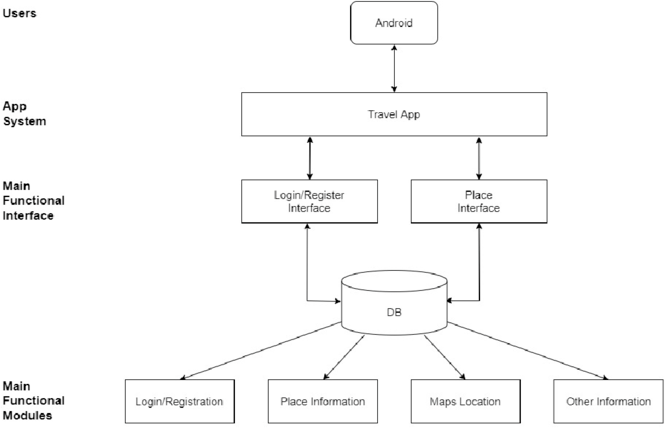
User Registration and Login: Users must register to access the services. Upon successful registration, their credentials are securely stored in the database. Registered users can log in and are directed to the homepage.
C. Homepage Navigation
The homepage features navigation buttons, including Home, About Us, Services, and Feedback.
Clicking on services directs users to a page offering four core services:
Search for Places Search for Cabs Search for Hotels Search for Events Selecting a service (e.g., cab booking) presents a form for the user to input details such as start location and destination.
Upon submission, the application calculates the price and provides an option to book the service.
Similar workflows are implemented for other services, like hotel or event bookings.
Feedback Submission: Users can provide feedback on their experience via a dedicated feedback form.
Feedback is stored in the database and accessible only to the admin for review and platform improvement.
D. Database Management
The application relies on Django’s ORM to interact with the database, ensuring robust data storage and retrieval. Key table include:
User Information: Stores registration and login credentials.
Service Data; Maintains details related to cab, hotel, and event bookings.
Feedback Records: Collects user feedback for administrative review.
E. User Authentication and Data Security
The platform incorporates user authentication to ensure secure access to the application. All sensitive information, including login credentials, is encrypted and stored securely in the database.
F. Purely Web-Based Application
This platform is designed exclusively as a web application, accessible through browsers. It prioritizes simplicity and accessibility to cater to users
V. SYSTEM DESIGN
A. Overview
Objective: provide a unified platform for tourists to book cabs, hotels, and events from a single app, offering and an integrated travel experience.
B. Key Components
Front end (user interface): mobile app for users to browse and cabs, hotels, and events web version for alternative access
Back end: Handles user authentication, data storage, booking logic, and payment processing.
Integrated with third-party services via APIs for real- time data on cabs, hotels, and events.
External APIs:
Cab Booking: Integration with ride-sharing platforms (uber, lyft).
Hotel Booking: Integration with platforms like Booking.com, Airbnb.
Event Booking: integration with event platforms (eventbrite, local venues).
C. System architecture
Micro services Architecture: separate services for cab, hotel, and event booking, each running independently but communicating via APIs.
Database: Centralized database for user data, bookings, payment transactions, and preferences.
Payment Gateway Integration: Enables secure payments for bookings (Stripe, PayPal).
D. Core Features
Booking System: Search and filter services (cabs, hotels, events) by location, price, availability, etc.
Seamless booking flow with real-time availability updates.
User authentication: Secure login/signup (OAuth/JWT) for personalized experience.
Notifications: Push and email notifications for booking confirmations, reminders, and updates.
E. Design Considerations
Scalability: Cloud-based hosting (AWS/Google Cloud) For global search and scalability.
Security: Encryption for transactions, secure payment Gateways and user data protection (GDPR- Compliant).
Performance: Caching frequently accessed data (e.g., hotel availability, popular events) to reduce latency and improve response times.
F. Future Enhancements
Personalized Recommendations: Leverage AI to suggest personalized travel experience, such as events and hotels, based on user wish.
Global Expansion: Integrating local service providers and offering expanded language options for international tourists..
VI. USE CASE DIAGRAM
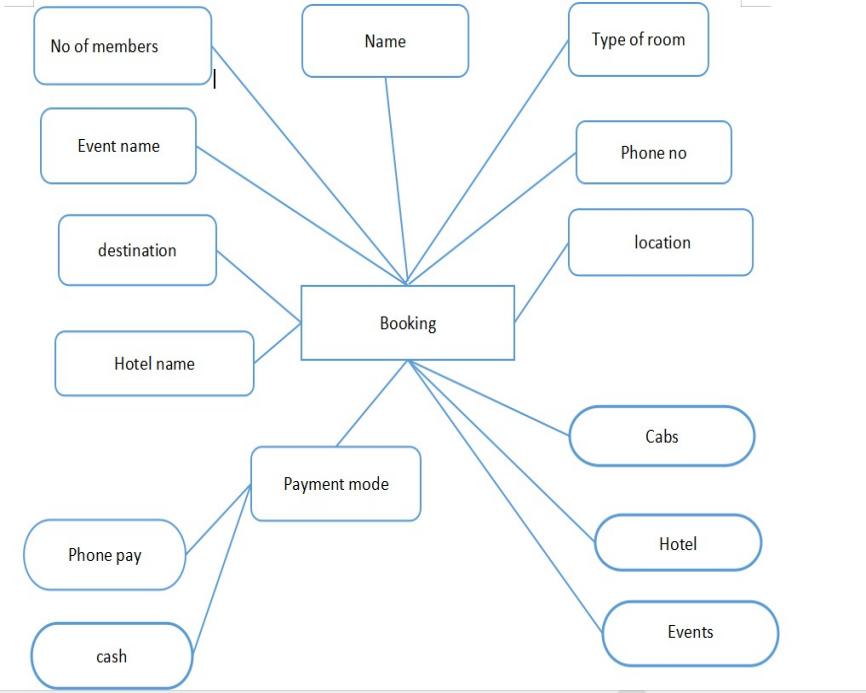
Level 0: Services
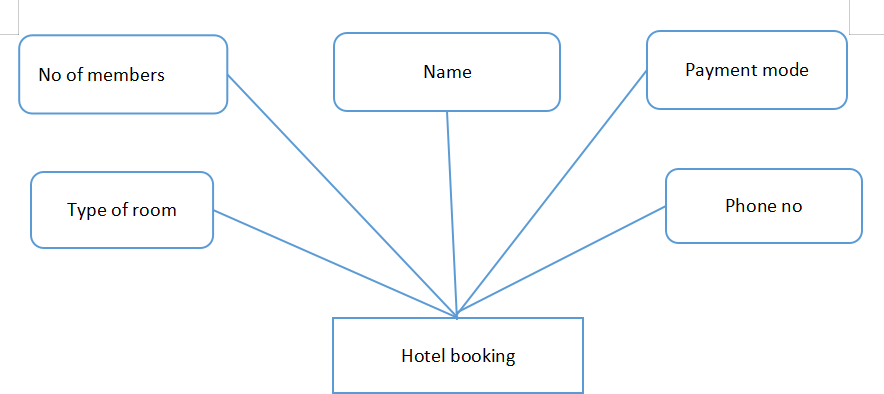
Level 1: Hotel Booking
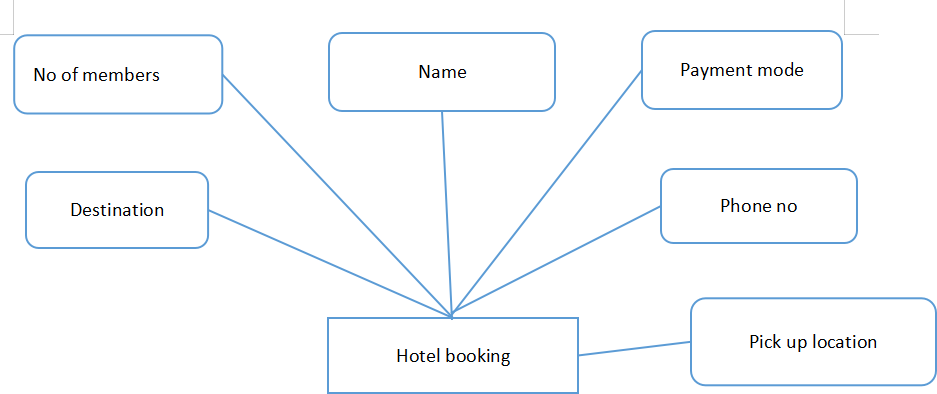
Level 2: Hotel Booking
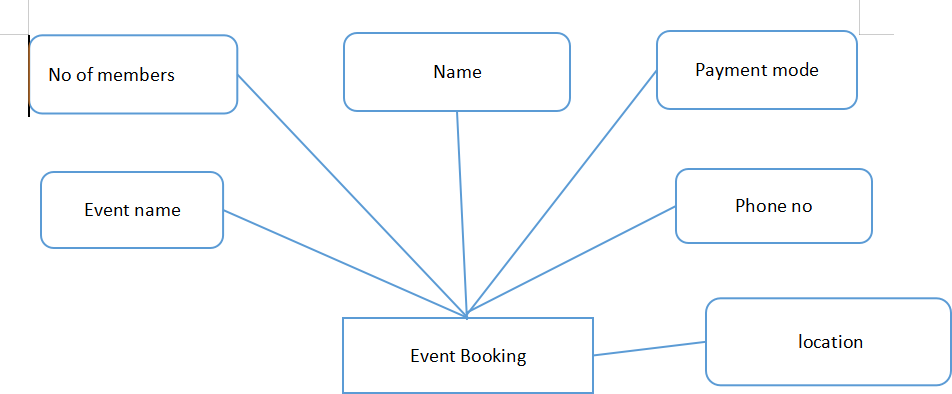
Level 3: Event Booking
VII. REQUIREMENTS
A. Software Requirements
Development: HTMI, CSS, JAVASCRIPT and Python for Back end
APIs: Hotel, cab, event.
VIII. RESULTS

Fig (1)
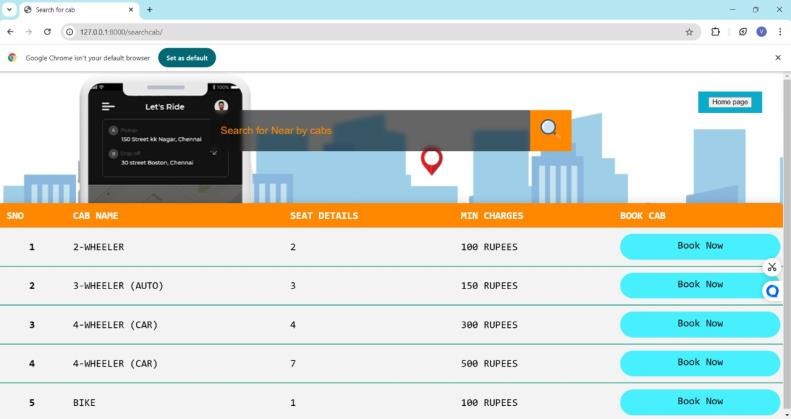
Fig (2)

Fig (3)
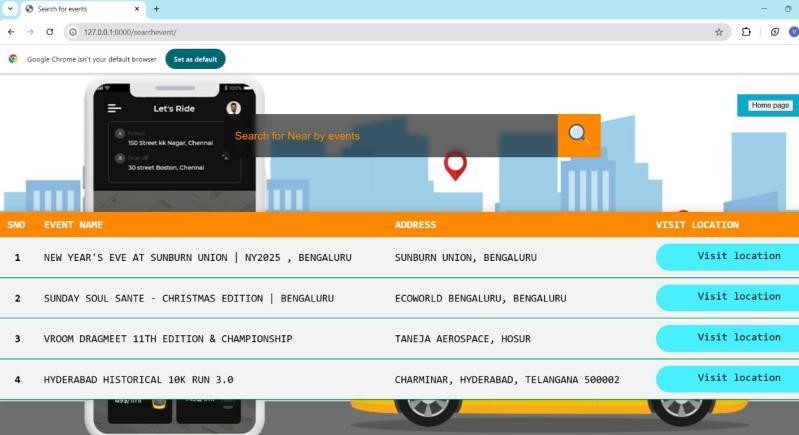
Fig (4)
Conclusion
The One-Stop Solution for tourism app brings together cab bookings, hotel reservations, and even tickets in one convenient platform. This simplifies the travel experience, allowing users to plan and book everything they need for their trip in just one place. The app ensures real-time updates, secure payments, and a smooth, easy-to-use interface. By combining essential travel services, it saves time and effort for tourists. In the future, the app can grow by adding personalized suggestions and expanding its offerings to more locations, making it an even more valuable tool for travelers everywhere. 1) In this app we integrate cab booking, hotel reservations, and event tickets into one platform, making it easier for users to plan and book their trip in one place. 2) We offering all travel services in a single app, it eliminates the need for users to switch between multiple apps, saving time and effort during the booking process. 3) The app features a simple, intuitive interface, making it easy for users to navigate and book services quickly and efficiently. 4) This app ensures real-time updates on the availability of cabs, hotel rooms, and events, helping users make informed decisions. 5) It integrates secure payment gateways, allowing users to make payments safely for booking and transactions 6) Users can manage all their bookings and preferences in one place, ensuring a smooth and organized travel experience. 7) This app can be enhanced with personalized travel recommendations and the addition of more service providers, improving its value for users. 8) This app has the potential to expand globally by supporting multiple languages and integrating more local service providers, making it accessible to a wider audience.
References
[1] ”The Traveler’s Tale: The One-Stop Solution for Tourism.” Journal of Tourism Research, vol. 12, no. 4, 2024, pp. 34-45. https://doi.org/xxxxxx [2] “Nomad Notes: Exploring the Digital Nomad Lifestyle.” Journal of Digital Nomad Studies, vol. 5, no. 2, 2024, pp. 112-124. https://doi.org/xxxxxx [3] “Travelogue Tales: A Journey Through Cultures and Destinations. “ Journal of Travel Literature, vol. 8, no. 3, 2024, pp. 56-67. https://doi.org/xxxxxx [4] “Destinations Diary: A Reflection on Global Travel.” Journal of Travel and Tourism, vol. 15, no. 3, 2024, pp. 45-59. https://doi.org/xxxxxx [5] “The Globe Journal: Exploring the World through Travel and Culture.” Global Studies Review, vol. 10, no. 2, 2024, pp. 78-92. https://doi.org/xxxxxx [6] “Epic Expeditions: Documenting the World’s Greatest Journeys.” Adventure and Travel Quarterly, vol. 20, no. 4, 2024, pp. 112-126. https://doi.org/xxxxxx [7] “The World in Words: Language, Culture, and Travel.” International Journal of Linguistic Studies, vol. 18, no. 1, 2024, pp. 34-47. https://doi.org/xxxx [8] “Adventure Archives: The Thrill of the Journey.” Journal of Adventure Tourism, vol. 25, 2024, pp. 89-103. https://doi.org/xxxxxx [9] “Trailblazer Journal: New Frontiers in Travel.” Journal of Innovative Tourism, vol. 13, no. 2,2024, pp. 56-70. https://doi.org/xxxxxx
Copyright
Copyright © 2025 Bathini Vasanthe, Pavithra P.S, Deekshitha O, Ms. Meena Kumari K. S. This is an open access article distributed under the Creative Commons Attribution License, which permits unrestricted use, distribution, and reproduction in any medium, provided the original work is properly cited.

Download Paper
Paper Id : IJRASET66533
Publish Date : 2025-01-15
ISSN : 2321-9653
Publisher Name : IJRASET
DOI Link : Click Here
 Submit Paper Online
Submit Paper Online

